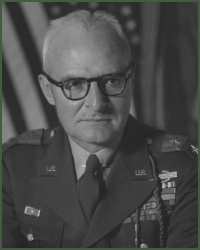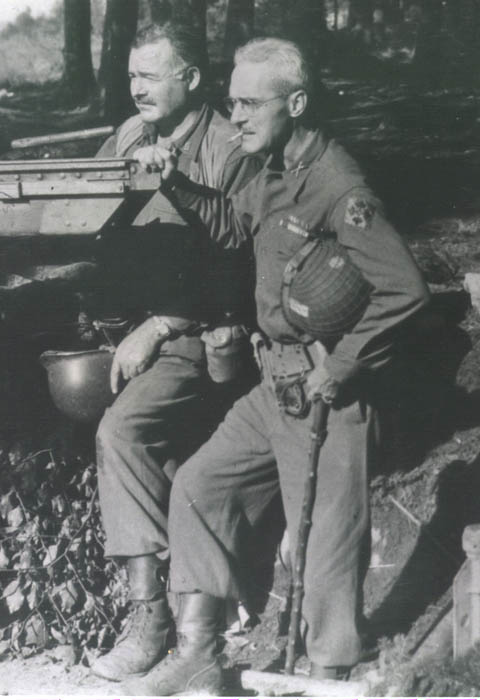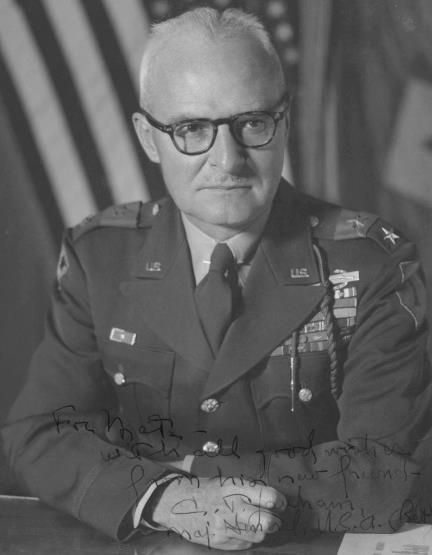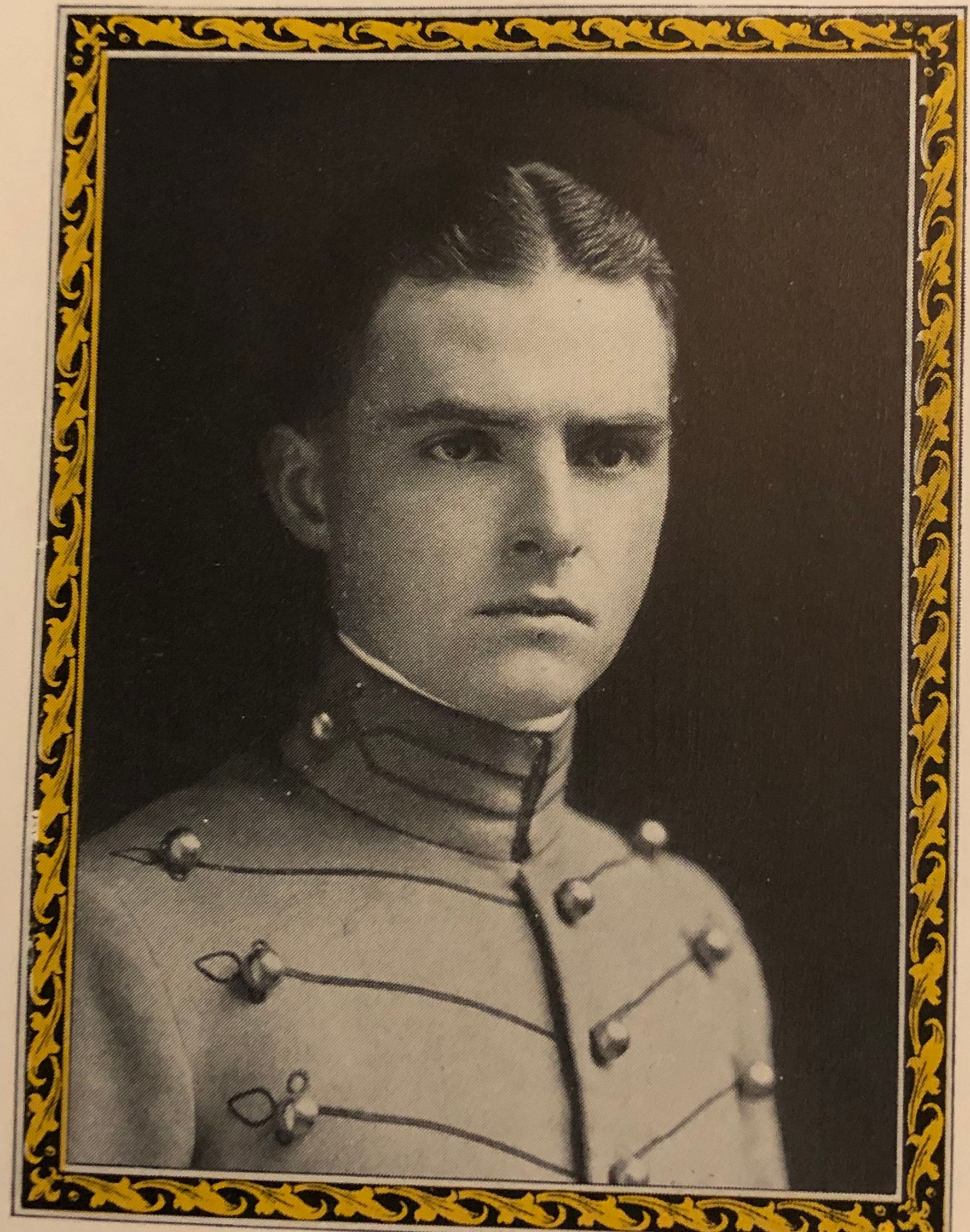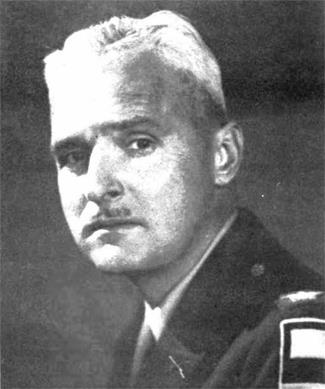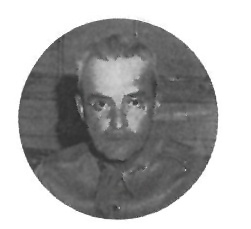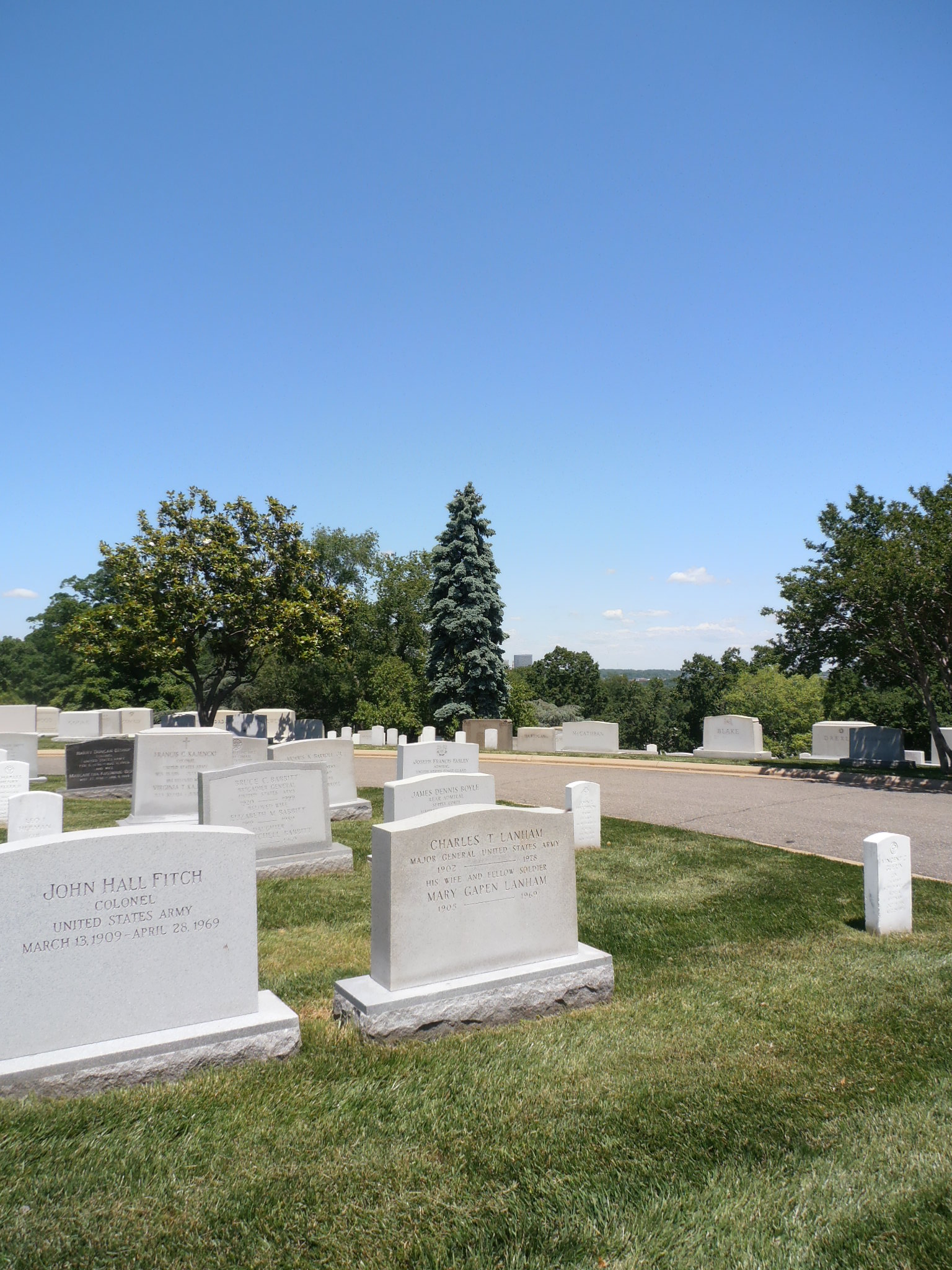Charles Trueman Lanham was born to Ira Clifford and Alice Bryan (O'Neil) Lanham on 14 September 1902 in Washington, DC. He attended Eastern High School in Washington, DC.
Charles, known as "Buck," graduated from the U. S. Military Academy on 12 June 1924, and was commissioned as a Second Lieutenant of Infantry, U.S. Army. His first assignment was with the 12th Infantry Regiment.
As a newly commissioned lieutenant, Lanham married Mary Gapen. Buck and Mary had one daughter, Shirley, and remained married until Mary's death in 1969.
On 6 March 1929, Buck was promoted to First Lieutenant. He attended the Infantry School in September 1931 and upon graduating, remained as an Instructor. Other assignments included Company Commander, 17th Infantry Regiment and, in February 1935, assignment to the National Guard Bureau.
Lanham's recognized abilities as a military trainer and theorist caused the Army brass to deny him field posts throughout the 1930s. In his spare time during the 1930's, he wrote sonnets, a few of which were published in Harper's Magazine, and some in pulp fiction. Buck was promoted to Captain on 1 August 1935. Later in 1935, he was appointed Assistant Chief, Supply Division and Associate Editor of the Infantry Journal. In September 1938, he attended the Command and General Staff School, graduating in 1939. He was later assigned as Company Commander of the 8th Infantry Regiment.
For Buck, 1941 was a busy year. In January, he was assigned to the Training Division Office, Chief of Infantry and on 31 January was promoted to Major. As World War II approached, Buck directed preparation of Infantry training manuals, then went to Hollywood where he wrote and supervised a widely used series of Army training films. On 24 December 1941, he was promoted to Lieutenant Colonel. In March 1942, Lanham was made Chief, Visual Aids Branch, Army Ground Forces.
Buck was promoted to Colonel on 6 January 1943 and, in March, was assigned as Regimental Commander of the 272nd Infantry Regiment, 69th Infantry Division.
On 9 July 1944, he was assigned as Regimental Commander of the 22nd Infantry Regiment, 4th Infantry Division. Division HQ was unhappy with the failure of the regiment to attain its objectives and to break the German resistance and Lanham was replacing Colonel Robert Foster, who had been relieved of command. Here was his actual introduction to the Regiment:
[A field phone rang. A Captain answered and heard this, "I am Colonel Charles T. Lanham. I have just assumed command of this Regiment, and I want you to know that if you ever yield one foot of ground without my direct order I will court-martial you." It was a proper introduction to "Buck" Lanham. But the Regiment began to fight with a skill, imagination and daring it would not have attempted before.]
His unit, along with the 2nd Armored Division, spearheaded the Normandy breakout and was the first unit into Paris. Under Colonel Lanham's command, the 22nd Regiment participated in the Battle of Hürtgen Forest. That was the name given to the series of fierce battles fought between U.S. and German forces during World War II in the Hürtgen Forest. This became the longest battle on German ground during WWII, and the longest single battle the U.S. Army has ever fought in its history. The battles took place between 14 September 1944 and 10 February 1945, over an area of barely 50 miles, east of the Belgian–German border.
Colonel Lanham's Regiment attacked the Siegfried Line and on 11 September 1944, the first American Infantrymen into Germany was a patrol from the 22nd Regiment. The 22nd Regiment sustained eighty percent casualties in nearly three weeks of combat. The unit was pulled off the frontline to be refitted and supplemented with replacements, but was rushed back into combat during the Battle of the Bulge, where the 22nd Regiment held a key position. For its actions, the 22nd Regiment was awarded two Presidential Unit Citations and Lanham received the Distinguished Service Cross for his bravery under fire.
Lanham was awarded his first star as a Brigadier General in February 1945 and on 3 March was made Assistant Division Commander of the 104th Infantry Division, which attacked Cologne and fought its way to a meeting with the Soviet Army on the Molde River. After commanding occupying forces based in Czechoslovakia and Austria, in November of 1945, he was called to Washington, DC to become General Omar Bradley's Chief of the War Department's Troop Information and Education Staff. Here, he directed training and personnel policies, first for the Army and then for the three services, which were undergoing unification. Some of the training materials came under criticism from right-wingers as being too liberal, or not sufficiently anti-Communist. Buck retorted at one hearing that they were opposed by both the Chicago Tribune - and the Daily Worker. He said convictions were as important as weapons, and that it was necessary to break down prejudices among troops. However, this criticism did not adversely affect his career and, in 1946, he was named Director of Staff of the Personnel Policy Board under Secretary of Defense Forrestal.
Brigadier General Lanham was transferred to the European Theater in 1949, where he served Belgium and Luxembourg as Chief of the Military Aid Group. In 1951, he became Chief Press Spokesman for General of the Army Dwight D. Eisenhower at Supreme Headquarters Allied Powers Europe (SHAPE), near Paris. In that position, it was Buck that announced Eisenhower's decision, in early 1952, to accept a draft for the Republican Party's nomination to be the President of the United States.
After his promotion to Major General, Buck took command of the 1st Infantry Division in West Germany in January 1953. In 1954, Gen. Lanham went to Norfolk, VA, on his final assignment as Deputy Commandant of the Armed Forces Staff College.
During his military service, General Lanham's many awards included the Distinguished Service Cross; the Distinguished Service Medal (Army); Bronze Star Medal; and the Combat Infantryman Badge.
Major General Lanham retired from active duty 31 December 1954.
A very interesting part of Buck Lanham's life began during WWII. It was in 1944, during the Battle of the Hürtgen Forest, that Buck first met the famous novelist, Ernest Hemingway. Hemingway was reporting on the war for Collier's, an American magazine, and requested assignment with Lanham's 22nd Infantry Regiment. They soon became close friends and he ended up making Lanham's command post his base as a reporter. Hemingway once described Colonel Lanham as "The finest and bravest and most intelligent military commander I have known."
Their friendship was so close that they maintained a steady correspondence for seventeen years, ending only upon Hemingway's death. While convalescing from his injuries, it is said that the novelist wrote to the soldier as he would to a father confessor. It is also widely reported that he built his portrayal of Colonel Cantwell, protagonist of "Across the River and Into the Trees," on the life of Lanham.
After his 31 December 1954 retirement and beginning with Market Relations Network, Lanham began a second career as a public relations executive for a number of companies. Time magazine, in its 28 November 1955 issue in the "PERSONNEL: Changes of the Week" column, reported:
"Major General Charles Trueman Lanham (ret.), 53, Dwight Eisenhower's chief press officer in SHAPE (and "prototype" of Colonel Cantwell, hero of Hemingway's Across the River and Into the Trees), is slated to be board chairman of Colt's Manufacturing Co., which was taken over last week by Penn-Texas Corp. (TIME, Oct. 3). Born in Washington, D.C., West Pointer "Buck" Lanham wrote poetry until it interfered with his Army career, later edited Infantry in Battle, a widely used Army textbook. In World War II, he fought through Normandy and the Bulge with the 22nd Infantry Regiment, earned a jacketful of decorations, including the Distinguished Service Cross."
The Penn-Texas Corporation's subsidiaries included Colt's Patent Firearms. The conglomerate went through a rapid expansion under the guidance of the Silberstein family, with who Lanham was closely aligned. The company's attempt to acquire Fairbanks, Morse and Company through a proxy and hostile takeover resulted in a public and acrimonious legal battle. Lanham resigned in 1958 following a disagreement with the Silberstein's over the direction of the company.
Lanham attempted to start his own company, Lanham-Patterson-Wilson, Inc., before joining Xerox in 1960 as Vice President for Government Relations. He retired from Xerox at the end of 1970 and spent his remaining years in Chevy Chase, MD, with his second wife, Jane Gay.
Major General Charles Trueman "Buck" Lanham died from cancer 20 July 1978 in Chevy Chase, MD, at the age of 75. He was preceded in death by his wife, Mary Gapen Lanham, on 27 April 1969. On their headstone, above Mary's name, are these words: "His Wife and Fellow Soldier."
Bio compiled by Charles A. Lewis
Honors
MG Charles T. Lanham has Honoree Record 3286 at MilitaryHallofHonor.com.
Charles Trueman Lanham was born to Ira Clifford and Alice Bryan (O'Neil) Lanham on 14 September 1902 in Washington, DC. He attended Eastern High School in Washington, DC.
Charles, known as "Buck," graduated from the U. S. Military Academy on 12 June 1924, and was commissioned as a Second Lieutenant of Infantry, U.S. Army. His first assignment was with the 12th Infantry Regiment.
As a newly commissioned lieutenant, Lanham married Mary Gapen. Buck and Mary had one daughter, Shirley, and remained married until Mary's death in 1969.
On 6 March 1929, Buck was promoted to First Lieutenant. He attended the Infantry School in September 1931 and upon graduating, remained as an Instructor. Other assignments included Company Commander, 17th Infantry Regiment and, in February 1935, assignment to the National Guard Bureau.
Lanham's recognized abilities as a military trainer and theorist caused the Army brass to deny him field posts throughout the 1930s. In his spare time during the 1930's, he wrote sonnets, a few of which were published in Harper's Magazine, and some in pulp fiction. Buck was promoted to Captain on 1 August 1935. Later in 1935, he was appointed Assistant Chief, Supply Division and Associate Editor of the Infantry Journal. In September 1938, he attended the Command and General Staff School, graduating in 1939. He was later assigned as Company Commander of the 8th Infantry Regiment.
For Buck, 1941 was a busy year. In January, he was assigned to the Training Division Office, Chief of Infantry and on 31 January was promoted to Major. As World War II approached, Buck directed preparation of Infantry training manuals, then went to Hollywood where he wrote and supervised a widely used series of Army training films. On 24 December 1941, he was promoted to Lieutenant Colonel. In March 1942, Lanham was made Chief, Visual Aids Branch, Army Ground Forces.
Buck was promoted to Colonel on 6 January 1943 and, in March, was assigned as Regimental Commander of the 272nd Infantry Regiment, 69th Infantry Division.
On 9 July 1944, he was assigned as Regimental Commander of the 22nd Infantry Regiment, 4th Infantry Division. Division HQ was unhappy with the failure of the regiment to attain its objectives and to break the German resistance and Lanham was replacing Colonel Robert Foster, who had been relieved of command. Here was his actual introduction to the Regiment:
[A field phone rang. A Captain answered and heard this, "I am Colonel Charles T. Lanham. I have just assumed command of this Regiment, and I want you to know that if you ever yield one foot of ground without my direct order I will court-martial you." It was a proper introduction to "Buck" Lanham. But the Regiment began to fight with a skill, imagination and daring it would not have attempted before.]
His unit, along with the 2nd Armored Division, spearheaded the Normandy breakout and was the first unit into Paris. Under Colonel Lanham's command, the 22nd Regiment participated in the Battle of Hürtgen Forest. That was the name given to the series of fierce battles fought between U.S. and German forces during World War II in the Hürtgen Forest. This became the longest battle on German ground during WWII, and the longest single battle the U.S. Army has ever fought in its history. The battles took place between 14 September 1944 and 10 February 1945, over an area of barely 50 miles, east of the Belgian–German border.
Colonel Lanham's Regiment attacked the Siegfried Line and on 11 September 1944, the first American Infantrymen into Germany was a patrol from the 22nd Regiment. The 22nd Regiment sustained eighty percent casualties in nearly three weeks of combat. The unit was pulled off the frontline to be refitted and supplemented with replacements, but was rushed back into combat during the Battle of the Bulge, where the 22nd Regiment held a key position. For its actions, the 22nd Regiment was awarded two Presidential Unit Citations and Lanham received the Distinguished Service Cross for his bravery under fire.
Lanham was awarded his first star as a Brigadier General in February 1945 and on 3 March was made Assistant Division Commander of the 104th Infantry Division, which attacked Cologne and fought its way to a meeting with the Soviet Army on the Molde River. After commanding occupying forces based in Czechoslovakia and Austria, in November of 1945, he was called to Washington, DC to become General Omar Bradley's Chief of the War Department's Troop Information and Education Staff. Here, he directed training and personnel policies, first for the Army and then for the three services, which were undergoing unification. Some of the training materials came under criticism from right-wingers as being too liberal, or not sufficiently anti-Communist. Buck retorted at one hearing that they were opposed by both the Chicago Tribune - and the Daily Worker. He said convictions were as important as weapons, and that it was necessary to break down prejudices among troops. However, this criticism did not adversely affect his career and, in 1946, he was named Director of Staff of the Personnel Policy Board under Secretary of Defense Forrestal.
Brigadier General Lanham was transferred to the European Theater in 1949, where he served Belgium and Luxembourg as Chief of the Military Aid Group. In 1951, he became Chief Press Spokesman for General of the Army Dwight D. Eisenhower at Supreme Headquarters Allied Powers Europe (SHAPE), near Paris. In that position, it was Buck that announced Eisenhower's decision, in early 1952, to accept a draft for the Republican Party's nomination to be the President of the United States.
After his promotion to Major General, Buck took command of the 1st Infantry Division in West Germany in January 1953. In 1954, Gen. Lanham went to Norfolk, VA, on his final assignment as Deputy Commandant of the Armed Forces Staff College.
During his military service, General Lanham's many awards included the Distinguished Service Cross; the Distinguished Service Medal (Army); Bronze Star Medal; and the Combat Infantryman Badge.
Major General Lanham retired from active duty 31 December 1954.
A very interesting part of Buck Lanham's life began during WWII. It was in 1944, during the Battle of the Hürtgen Forest, that Buck first met the famous novelist, Ernest Hemingway. Hemingway was reporting on the war for Collier's, an American magazine, and requested assignment with Lanham's 22nd Infantry Regiment. They soon became close friends and he ended up making Lanham's command post his base as a reporter. Hemingway once described Colonel Lanham as "The finest and bravest and most intelligent military commander I have known."
Their friendship was so close that they maintained a steady correspondence for seventeen years, ending only upon Hemingway's death. While convalescing from his injuries, it is said that the novelist wrote to the soldier as he would to a father confessor. It is also widely reported that he built his portrayal of Colonel Cantwell, protagonist of "Across the River and Into the Trees," on the life of Lanham.
After his 31 December 1954 retirement and beginning with Market Relations Network, Lanham began a second career as a public relations executive for a number of companies. Time magazine, in its 28 November 1955 issue in the "PERSONNEL: Changes of the Week" column, reported:
"Major General Charles Trueman Lanham (ret.), 53, Dwight Eisenhower's chief press officer in SHAPE (and "prototype" of Colonel Cantwell, hero of Hemingway's Across the River and Into the Trees), is slated to be board chairman of Colt's Manufacturing Co., which was taken over last week by Penn-Texas Corp. (TIME, Oct. 3). Born in Washington, D.C., West Pointer "Buck" Lanham wrote poetry until it interfered with his Army career, later edited Infantry in Battle, a widely used Army textbook. In World War II, he fought through Normandy and the Bulge with the 22nd Infantry Regiment, earned a jacketful of decorations, including the Distinguished Service Cross."
The Penn-Texas Corporation's subsidiaries included Colt's Patent Firearms. The conglomerate went through a rapid expansion under the guidance of the Silberstein family, with who Lanham was closely aligned. The company's attempt to acquire Fairbanks, Morse and Company through a proxy and hostile takeover resulted in a public and acrimonious legal battle. Lanham resigned in 1958 following a disagreement with the Silberstein's over the direction of the company.
Lanham attempted to start his own company, Lanham-Patterson-Wilson, Inc., before joining Xerox in 1960 as Vice President for Government Relations. He retired from Xerox at the end of 1970 and spent his remaining years in Chevy Chase, MD, with his second wife, Jane Gay.
Major General Charles Trueman "Buck" Lanham died from cancer 20 July 1978 in Chevy Chase, MD, at the age of 75. He was preceded in death by his wife, Mary Gapen Lanham, on 27 April 1969. On their headstone, above Mary's name, are these words: "His Wife and Fellow Soldier."
Bio compiled by Charles A. Lewis
Honors
MG Charles T. Lanham has Honoree Record 3286 at MilitaryHallofHonor.com.
Inscription
On the back of the headstone:
"Say only this of me when I am Dead 'He saw proud eagles storming down the sky, He heard the bracken brake where beauty fled And, wingless, strove to fly.'"
